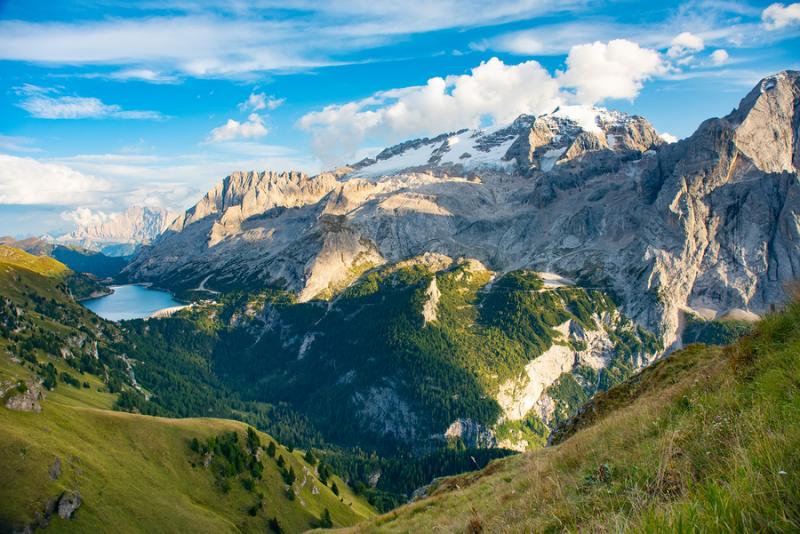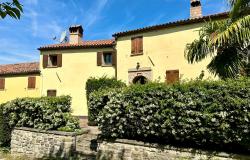Located about 100 km northwest of Venice, at the border between Trentino and Veneto, the Marmolada is known as ‘la regina delle Dolomiti’, the Queen of the Dolomites; besides the different rock formations and the fact that it boasts the highest peak of the group (3,343m), its glacier, the largest in the Dolomites, and its impressive south wall contributed to giving the mountain that appellation.
The north slope of the Marmolada, which contains the glacier, can be admired from all major lookout points across the Dolomites; one of the most idyllic views is the one that includes Fedaia Lake, whose waters are fed by the melting water of the glacier (see photo above). The north side can also be easily reached via cable car.
But the imposing south wall, you have to conquer by going on a beautiful hike.
For both excursions (cable car and on foot), start at Malga Ciapela (1,450m), at the foot of the Marmolada.
Malga Ciapela is the departure station of the famous Marmolada cable car, which reaches Punta Rocca (3,265m) near Punta Penia, the highest peak of the Marmolada. On the way up, you can get off at the Serauta station (2,950m) to visit the Museo Marmolada Grande Guerra (Great War Marmolada Museum), which recounts the battles that took place in these mountains during World War I, when they constituted the border between Austria-Hungary and Italy.
The museum, the highest located in Europe, was inaugurated in 1990, then enlarged and renovated in 2015 for the 100th anniversary of the Great War. It reproduces the environment and life conditions of soldiers at high altitude, from the ‘death trench’ to the ‘ice city’ carved by the Austrians below the glacier. It includes original finds such as letters, journals, photos and objects. Visitors experiences war through the eyes of the soldiers in their daily life made of extreme conditions, among rocks, ice, freezing temperatures, where avalanches killed more than battles. It includes equipment that simulates the cold temperatures and the difficulty breathing at 3,000 meters of altitude.
Outside the museum is the Zona Monumentale Sacra (Sacred Monumental Zone), with Italian and Austrian stations restored by a group of volunteers.
Once you reach the top station of the cable car, Punta Rocca, get off to admire an amazing 360° view over the Dolomites from a superb natural terrace.
For the best views over the south wall of the Marmolada, do the hike that starts at Malga Ciapela and reaches Rifugio Falier. This path affords impressive views over the south wall of the Marmolada because you’ll be standing right below it. The south wall is a colossal marine cliff consisting mainly of light-colored limestone, in a slight contradiction for the Queen of the Dolomites which isn’t mainly made of dolomite, the carbonate rock that gave the name to these mountains, named for 18th-century French mineralogist Déodat Gratet de Dolomieu, who was the first to describe the mineral.
In Val Ombretta at 2,074m of altitude, Rifugio Falier is the best vantage point over the imposing south wall of the Marmolada. It’s named after Onorio Falier, the Venetian nobleman who financed its reconstruction after World War I bombings.

[Rifugio Falier. Photo by Silvia Donati.]
The hut owner proudly states that people come from all over the world to admire and to climb it. Some of the most famous climbers in the world have climbed or opened new routes on the south wall of the Marmolada – the first person to climb it to the top, to Punta Penia, was a woman in 1901, English mountaineer Beatrice Tomasson, one of the strongest climbers of her time, along with guides Michele Bettega and Bortolo Zagonel; the route had been considered ‘the longest and most difficult climb in the Alps’ for more than a decade, yet Tomasson's team made the ascent in just one day. It is said that when they reached the top, they celebrated by uncorking a bottle of champagne.
Rifugio Falier makes for a perfect lunch break, since you’re going to reach it by lunch time if you start at Malga Ciapela around 10 am. On the way back, you may want to stop at Malga Ombretta, famous, and rightly so, for its yogurt and cheese made on the premises.
Also, return via the Vallon dell’Ombretta where you’re likely to hear the whistles of marmots.













